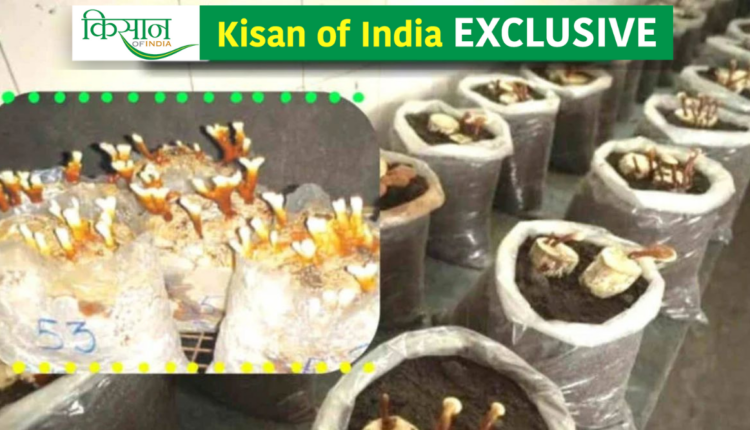Ganoderma Cultivation: Single seed of Ganoderma mushroom, harvest three times!
Which home remedy will remove the deficiency of 'autoclave' in Ganoderma Cultivation?
Ganoderma Cultivation is a slow process, but its crop matures in 3 to 5 weeks after sowing. To get its yield, the Ganoderma mushroom is broken by twisting. One can use it for a long time by drying it and making its powder. To harvest the fruits of Ganoderma, uproot them or cut them at the root with pruning shears, skaters, and clipping scissors.
After harvesting, dry the produce in the shade for 7 to 10 days and then dry it in an oven or autoclave at 60°C for 4 hours. This will bring down the moisture level of Ganoderma to 9-10 percent. After this, it should be sealed in polypacks and stored in a dry place. Ganoderma mushroom contains about 60 percent moisture at the time of harvesting. In Ganoderma cultivation, after drying, 400 grams of dry Ganoderma is obtained from one kilogram of produce.
Three Crops from One Seed of Ganoderma
After harvesting the first crop, the environment of the initial phase should be repeated. This means keeping the room temperature at 30°C and the humidity level above 90 percent, besides ensuring fresh air and light availability. Similarly, post-pinning actions are also performed identically. This gives three flushes from one spawning of Ganoderma and completes one crop cycle.

Diseases and Pests
Ganoderma is produced by organic or biological methods on a sterilized medium. This makes it easier to protect the crop from diseases and insects. Nevertheless, cleanliness should also be taken care of in the production room of Ganoderma. Similarly, there should be a filtered airflow in the production room. There should be a fine mesh on the windows and doors for this. The use of chemical fungicides on Ganoderma is prohibited, so if any disease or insects come into the production room, there may be a need to throw away the produce.
A yellow-bulb trap should be used if a few insects are seen in the production room. In this technique, apply some oil on a 1-meter x 0.5-meter polysheet, hang it on the wall, and hang a 15-watt yellow bulb over it. Flies and insects are attracted to the yellow light and get stuck in the oil on the sheet.
Sometimes the symptoms of green molds may appear before the fungus fully spreads on the mixture or medium of sawdust in a plastic bag. If this happens, the whole plastic bag should be removed from the production room and buried in the ground somewhere far away. Keep in mind that using any pesticide on Ganoderma can affect its quality. On finding a deficiency during its investigation, the buyer rejects (cancels) the entire product by calling it useless.
Processing and Marketing of Ganoderma
For the processing of Ganoderma mushroom, its fruit bodies or bunches are thoroughly dried and ground into powder. Many companies make capsules from its powder as a commercial product and sell it in the market at the rate of Rs 1,100 to 1,300 per 100 capsules and Rs 1,150 to 1,350 per 50 grams of powder.
You can also drink Ganoderma mushroom powder after dissolving it in water. By adding lemon grass to a cup of water, adding some honey and Ganoderma mushroom powder to it, you can also drink it like green tea. Soaps, creams and toothpaste are also made from it. Women’s groups producing Ganoderma seeds also get huge economic benefits. Horticulture departments can also easily produce and propagate it.
Also Read: High income from cultivation of Ganoderma Mushroom
Seed Production of Ganoderma
Ganoderma spawn or master culture, master or mother spawn, is produced in the same way that spawn of other mushroom species can be produced from wheat grain. In many countries, spawn of Ganoderma is also made on wood sawdust. Autoclave (or Boiler+Retort), Laminarflow (Clean Air Station) and B.O.D. Requires facilities or equipment such as an incubator. Mobilizing these equipments is extremely difficult for ordinary farmers. Therefore, farmers are generally advised to buy high quality spawn of Ganoderma from certified organizations only.
Significance of the Autoclave Process
The ‘autoclave’ machine is very much like a pressure cooker. Using this, surgical instruments in hospitals are made infection free. The pieces of wood wrapped in paper are kept in the autoclave machine. Wood logs or the medium supporting them are sterilized by the process of autoclave. Since the use of any kind of medicine and fungicide is prohibited in Ganoderma cultivation, the role of autoclave process becomes very important to protect the yield from any danger. For the process of sterilization, scientists have also developed a home remedy for those farmers, which we will talk further in this article.
Home Remedies for Sterilization
Dr. Alankar Singh, scientist at Krishi Vigyan Kendra, Pithoragarh, says that if the ‘autoclave’ machine is not accessible for the cultivation of Ganoderma mushroom, then the pieces of the girl should be kept overnight in a solution of one liter of water and two milliliters of formalin. The next day the pieces of these chicks are boiled in another solution prepared by adding 0.5 ml of ‘malt extract’ made from wheat per liter of water. Then after cooling, the sticks are tied in polythene and kept in the sun for a temperature of 45-50 degree Celsius. This is called solarization.
Due to this, the wooden logs or the medium which nourishes them becomes completely sterile or sterilized. In sawdust method also the same procedure as in logs is adopted for sterilizing the medium. The medium mixture containing sawdust is also melted by soaking in water for about 20 hours. Then the water is filtered to keep its moisture level around 65 percent. It is then passed through the in-house sterilizer process and the rest of the process is carried out as described above.
Also Read: Ganoderma is a Mushroom with Medicinal Properties
Domestic production of ‘Malt Extract’
For home production of wheat malt extract, first germinate its grains. Then on drying the germinated grains with hot air, this wheat malt is made. Add enough water to this malt and heat it on the stove till the foamy substance coming out of it becomes thick. When this liquid cools down, filter it and fill it in a bottle. This is malt extract. Malting produces enzymes that convert the starch (maad) present in the grain into sugar (glucose) and such a form of protein from which yeast or vinegar is easily formed.
Contact us – If farmers want to share any valuable information or experiences related to farming, they can connect with us via phone or whatsapp at 9599273766 or you can write to us at “[email protected]”. Through Kisan of India, we will convey your message to the people, because we believe that if the farmers are advanced then the country is happy.
You can connect with Kisan of India on Facebook, Twitter, and Whatsapp and Subscribe to our YouTube channel.





